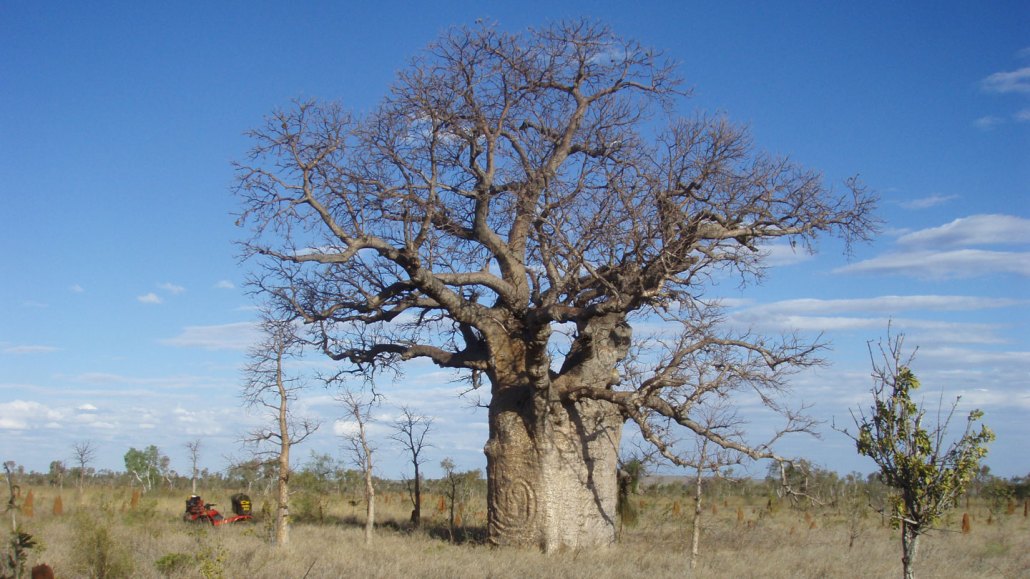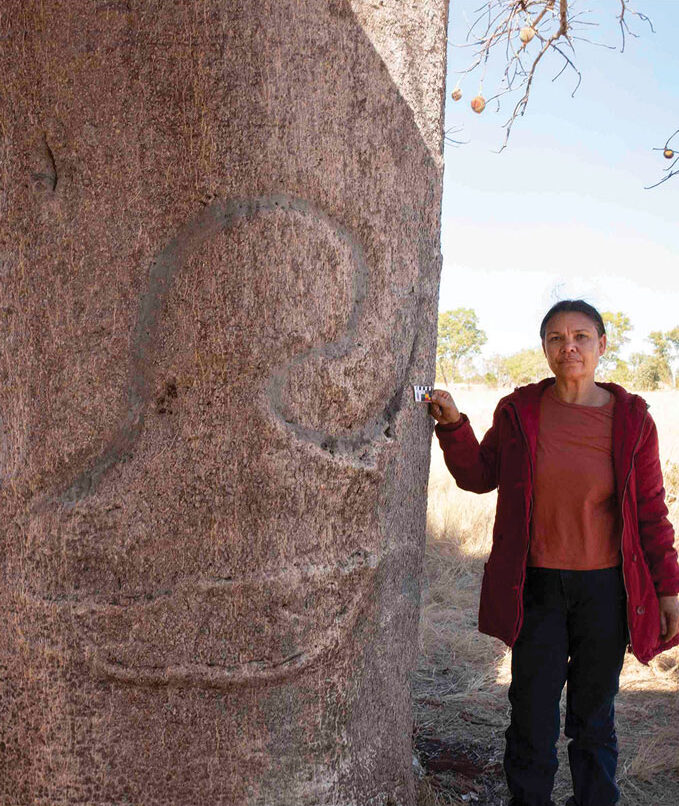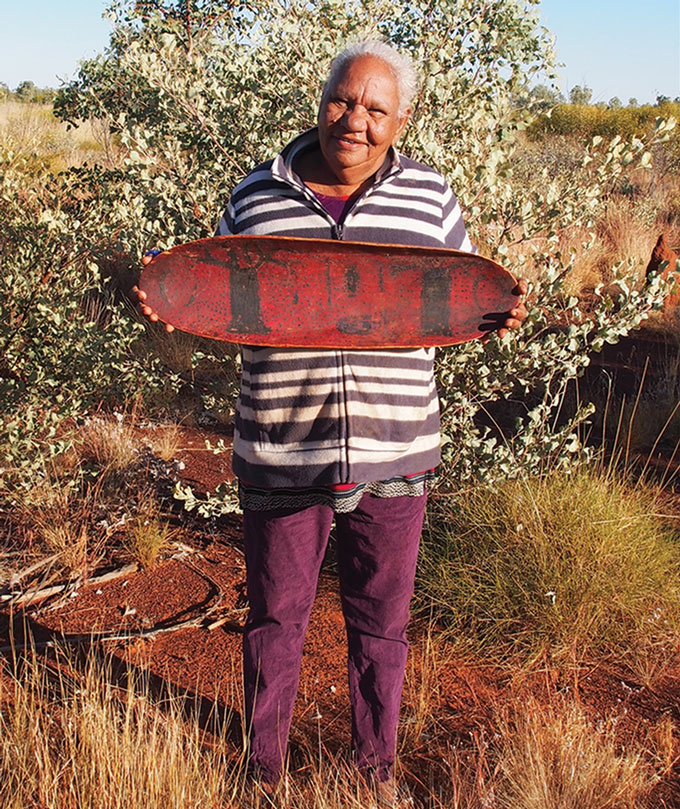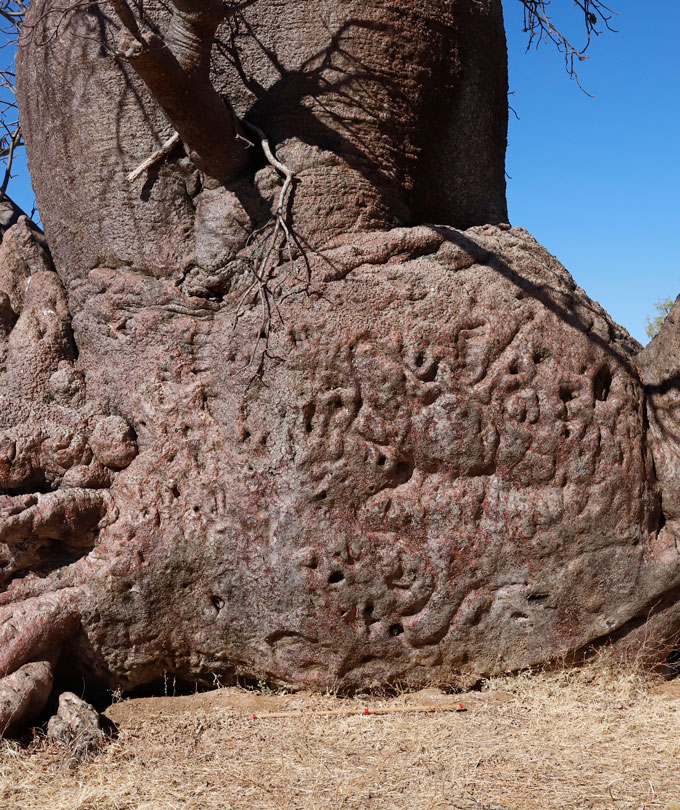Carvings on Australia’s boab trees reveal a people’s lost history
Researchers and an Aboriginal family are racing against time to find ties to the land

This boab is engraved with the image of a snake. It’s one of 12 carved trees rediscovered during a 2021 expedition into Australia’s Tanami Desert. The carvings have cultural ties to the Jaru, an Aboriginal group from the Kimberley region in northwestern Australia.
D. Lewis
Share this:
- Share via email (Opens in new window) Email
- Click to share on Facebook (Opens in new window) Facebook
- Click to share on X (Opens in new window) X
- Click to share on Pinterest (Opens in new window) Pinterest
- Click to share on Reddit (Opens in new window) Reddit
- Share to Google Classroom (Opens in new window) Google Classroom
- Click to print (Opens in new window) Print
By Freda Kreier
Brenda Garstone is on the hunt for her heritage.
Parts of her cultural inheritance are scattered across the Tanami Desert in northwestern Australia. There, dozens of ancient boab trees are engraved with Aboriginal designs. These tree carvings — called dendroglyphs (DEN-droh-glifs) — could be hundreds or even thousands of years old. But they’ve received almost no attention from Western researchers.
That is slowly starting to change. Garstone is Jaru. This Aboriginal group hails from the Kimberley region of northwestern Australia. In the winter of 2021, she teamed up with archaeologists to find and document some boab carvings.

For Garstone, the project was a bid to piece together parts of her identity. Those pieces were scattered 70 years ago when Garstone’s mother and three siblings were separated from their families. Between 1910 and 1970, an estimated one-tenth to one-third of Aboriginal children were taken from their homes by the Australian government. Like many others, the siblings were sent to live at a Christian mission thousands of kilometers (miles) from home.
As teens, the siblings returned to their mother’s homeland and reconnected with their extended family. Garstone’s aunt, Anne Rivers, had been just two months old when she was sent away. One family member now gave her a type of shallow dish. Called a coolamon, it was decorated with two bottle trees, or boabs. Her family told Rivers that those trees were part of her mother’s Dreaming. That’s a name for the cultural story that connected her and her family to the land.
Now, researchers have carefully described 12 boabs in the Tanami Desert with dendroglyphs that have links to Jaru culture. And just in time: The clock is ticking for these ancient engravings. The host trees are ailing. That’s partly due to their age and partly to growing pressure from livestock. They may also be affected by climate change.
Garstone was part of the team that described these carvings in the December issue of Antiquity.
In the race against time, there’s more at stake than just studying an ancient form of art. It’s also the need to heal wounds inflicted by policies that aimed to erase the connection between Garstone’s family and their homeland.
“To find evidence that ties us to the land has been amazing,” she says. “The puzzle we’ve been trying to piece together is now complete.”
An outback archive
Australian boabs proved pivotal to this project. These trees grow in the northwestern corner of Australia. The species (Adansonia gregorii) can be recognized easily by its massive trunk and iconic bottle shape.
Writings about trees carved with Aboriginal symbols in Australia date back to the early 1900s. These records indicate that people were continuously carving and recarving some trees until at least the 1960s. But the carvings aren’t as well known as some other types of Aboriginal art, such as rock paintings. “There does not appear to be a wide general awareness of [boab carvings],” says Moya Smith. She works at the Western Australia Museum in Perth. A curator of anthropology and archaeology, she was not involved with the new study.
Darrell Lewis has come across his share of carved boabs. He’s a historian and archaeologist in Australia. He works at the University of New England in Adelaide. Lewis has worked in the Northern Territory for half a century. In that time, he’s spotted engravings made by all different groups of people. Cattle drovers. Aboriginal peoples. Even World War II soldiers. He calls this mixed bag of engravings “the outback archive.” He says it’s a physical testament to the people who have made this rugged part of Australia their home.
In 2008, Lewis was searching the Tanami Desert for what he hoped would be his biggest find. He’d heard rumors about a cattle drover working in the area a century earlier. The man, so the story went, had found a firearm stashed in a boab marked with the letter “L.” A roughly cast brass plate on the gun was stamped with a name: Ludwig Leichhardt. This famed German naturalist had disappeared in 1848 while traveling across western Australia.
The museum that now owned the gun hired Lewis to look for the rumored “L” tree. The Tanami was thought to be outside the boab’s natural range. But in 2007, Lewis rented a helicopter. He crisscrossed the desert in search of the Tanami’s secret stash of boabs. His flyovers paid off. He spotted roughly 280 centuries-old boabs and hundreds of younger trees scattered across the desert.
“Nobody, not even locals, really knew there were any boabs out there,” he recalls.
Finding lost boab carvings
Boab trees grow in the northwestern corner of Australia. A survey (green rectangle) near the edge of the Tanami Desert revealed a patch of boab trees carved with dendroglyphs. The carvings tie the region to the path of the Lingka Dreaming (gray arrow). This trail connects cultural sites across hundreds of kilometers.
He embarked on a ground expedition in 2008. He never did spot the elusive “L” boab. But the search did uncover dozens of boabs marked with dendroglyphs. Lewis recorded the location of these trees in a report for the museum.
That information sat untouched for years. Then one day, it fell into the hands of Sue O’Connor.
Crumble into dust
O’Connor is an archaeologist at Australian National University in Canberra. In 2018, she and other archaeologists were growing more and more concerned about the survival of boabs. That year, scientists studying a close relative of boabs in Africa — baobabs — noticed a worrying trend. Older trees were dying at a surprisingly high rate. The scientists thought climate change might be playing some role.
The news alarmed O’Connor. Dendroglyphs are often engraved on the largest and oldest boabs. Nobody knows exactly how old these trees can get. But researchers suspect that their lifetimes could be comparable to their African cousins. And baobabs can live more than 2,000 years.
When these long-lived trees do die, they pull a disappearing act. Other trees’ wood can be preserved for hundreds of years after death. Boabs are different. They have a moist and fibrous interior that can quickly disintegrate. Lewis has witnessed boabs crumble into dust a couple of years after dying.
Afterward, he says, “You would never know there’d been a tree there.”
Whether Australian boabs are threatened by climate change is unclear. But the trees are coming under attack from livestock. The animals peel back boabs’ bark to get to the wet interior. Considering all of this, O’Connor “thought we better try and locate some of the carvings.” After all, she says, “they probably won’t be there in a few years.”
Lewis’s report provided a good jumping-off point for this work. So O’Connor reached out to the historian and suggested they work together.
Around that same time, Garstone was four years into her own research into her family’s heritage. The long and meandering search led her to a small museum. It happened to be run by a friend of Lewis’s. When Garstone mentioned she was from Halls Creek — a town near where Lewis did his fieldwork in 2008 — the curator told her about the carved boabs.
“What?” she recalls: “That’s a part of our Dreaming!’”

Dreamings are a Western term used for the vast and diverse stories that — among other things — recount how spiritual beings formed the landscape. Dreaming stories also pass down knowledge and inform rules of behavior and social interactions.
Garstone knew her grandmother had ties to the Bottle Tree Dreaming. The trees featured in an oral history passed down through her family. And they were painted on her aunt’s coolamon. The Bottle Tree Dreaming is one of the eastern-most signs of the Lingka Dreaming track. (Lingka is the Jaru word for the King Brown Snake.) This path spans hundreds of kilometers (miles). It runs from the western coast of Australia into the neighboring Northern Territory. It marks Lingka’s journey across the landscape. It also forms a byway for people to travel across the country.
Garstone was eager to confirm that the boabs were a part of this Dreaming. She, her mother, her aunt and a few other family members joined the archaeologists on their mission to rediscover the boabs.
Into the Tanami
The group set out from the town of Halls Creek on a winter day in 2021. They set up camp on a remote station mainly populated by cattle and feral camels. Each day, the team climbed into all-wheel-drive vehicles and headed out to the last known location of the engraved boabs.
It was hard work. The crew often drove hours to the supposed position of a boab, only to find nothing.
They had to stand on top of the vehicles and scan for trees in the distance. What’s more, wooden stakes sticking out of the ground constantly shredded the vehicles’ tires. “We were out there for eight or 10 days,” says O’Connor. “It felt longer.”

The expedition was cut short when they ran out of tires — but not before finding 12 trees with dendroglyphs. The archaeologists painstakingly documented these. They took thousands of overlapping pictures to make sure these images covered every part of each tree.
The team also spotted grinding stones and other tools scattered around the base of these trees. In a desert with little cover, large boabs provide shade. These tools suggest that people probably used the trees as resting spots while crossing the desert. The trees likely also served as navigational markers, the researchers say.
Some of the carvings showed emu and kangaroo tracks. But by far the largest number depicted snakes. Some undulated across the bark. Others coiled onto themselves. The knowledge provided by Garstone and her family, along with historical records from the area, points toward the carvings being linked to the King Brown Snake Dreaming.
“It was surreal,” Garstone says. Seeing the dendroglyphs confirmed the stories passed down in her family. It’s “pure evidence” of their ancestral connection to country, she says. This rediscovery has been healing, especially for her mother and aunt, both in their 70s. “All of this was nearly lost because they didn’t grow up in their homeland with their families,” she says.
Maintaining the connection
The work to find and document carved boabs in the Tanami has just begun. There may be engraved trees in other parts of the country, too. This trip shows the “vital importance” of scientists working together with First Nations knowledge-holders, says Smith at the Western Australia Museum.
O’Connor is organizing another expedition. She hopes to find more of the engravings Lewis had spotted. (She plans to take better wheels. Or better yet, a helicopter.) Garstone is planning on coming along with more of her extended family in tow.
For now, O’Connor says this work appears to have stimulated others’ interest. Researchers and other Aboriginal groups want to rediscover the overlooked boab carvings and preserve them for future generations.
“Our connection to country is so important to maintain because it makes us who we are as First Nations people,” says Garstone. “To know that we have a rich cultural heritage and to have our own museum in the bush is something we will treasure forever.”







